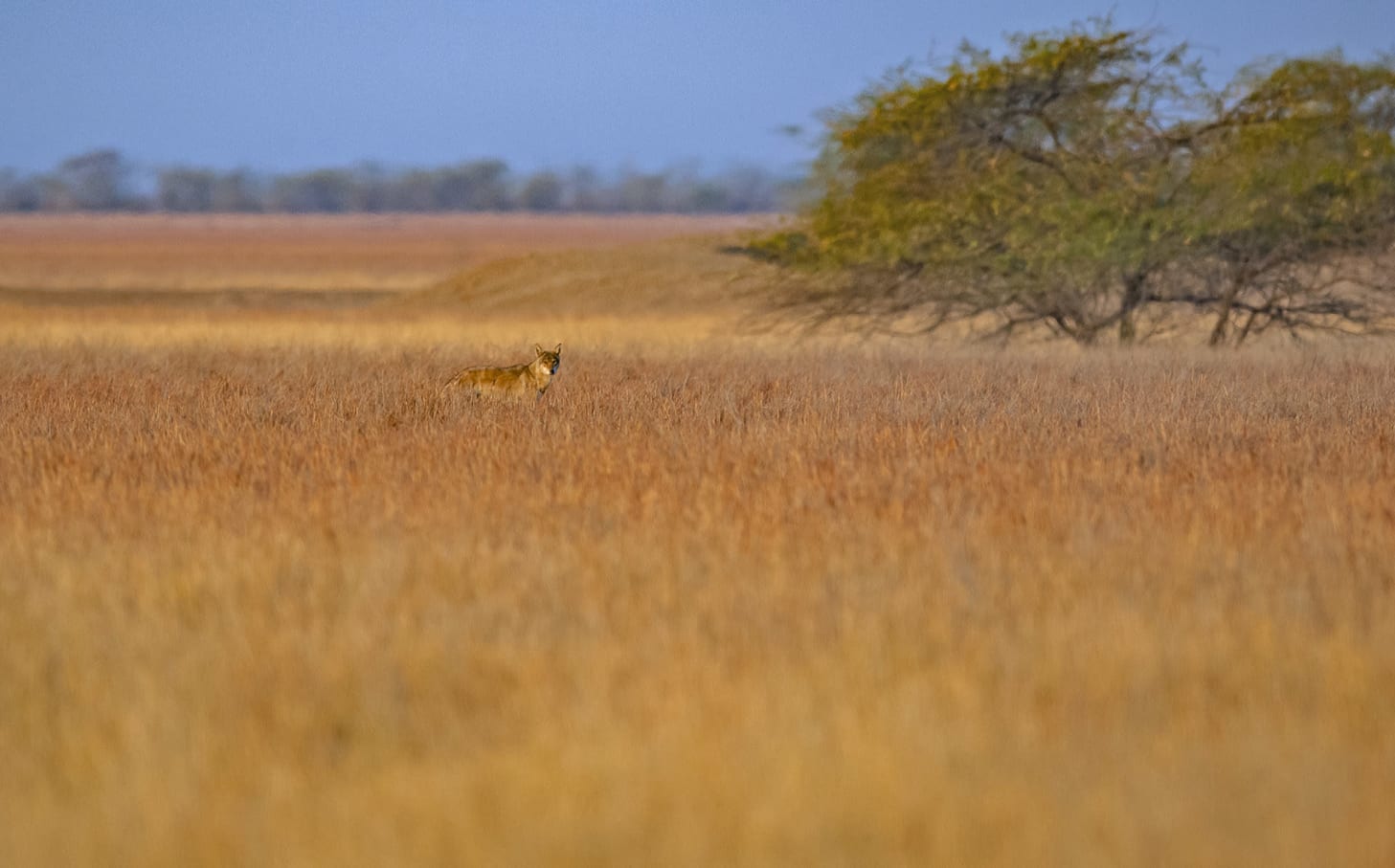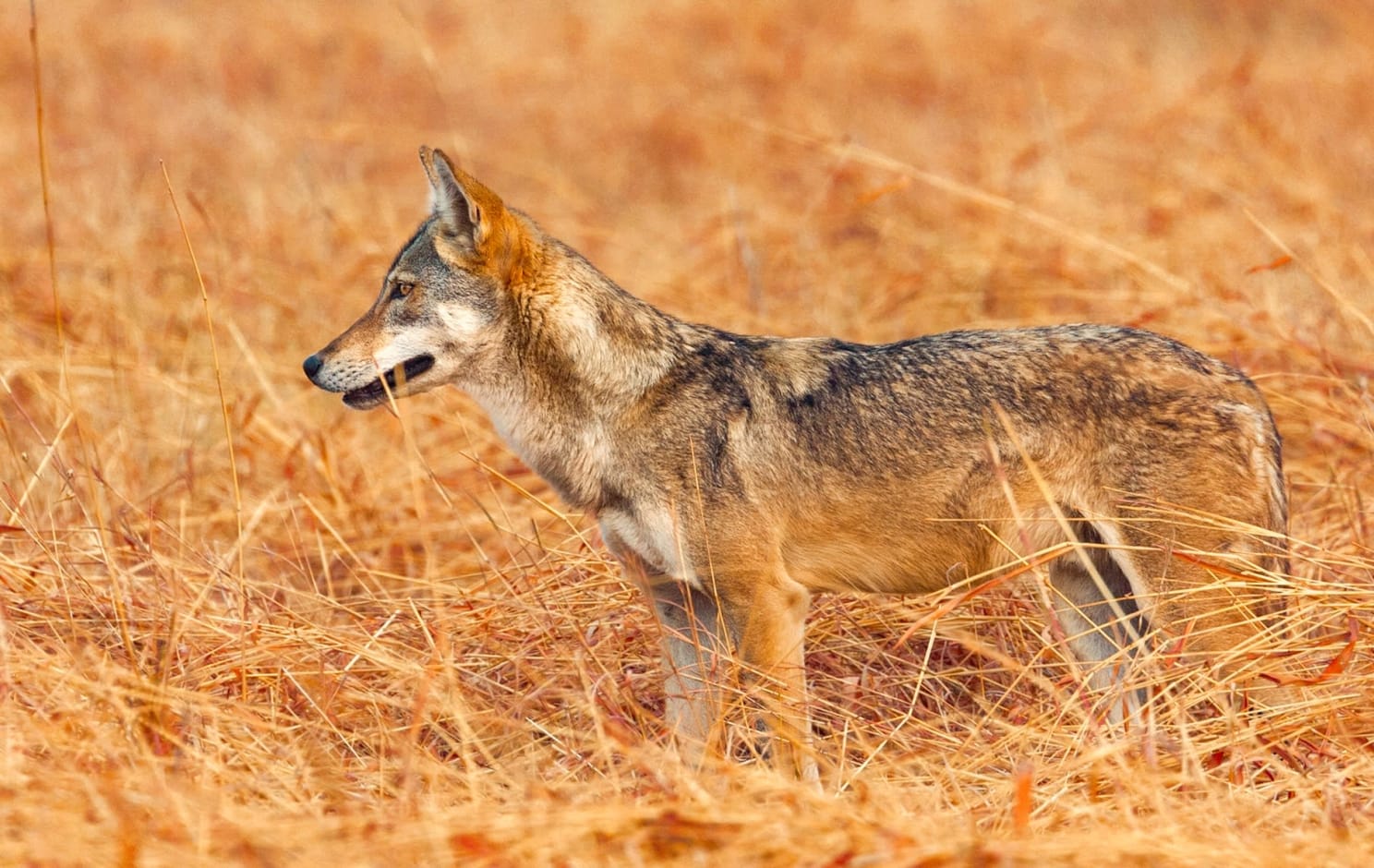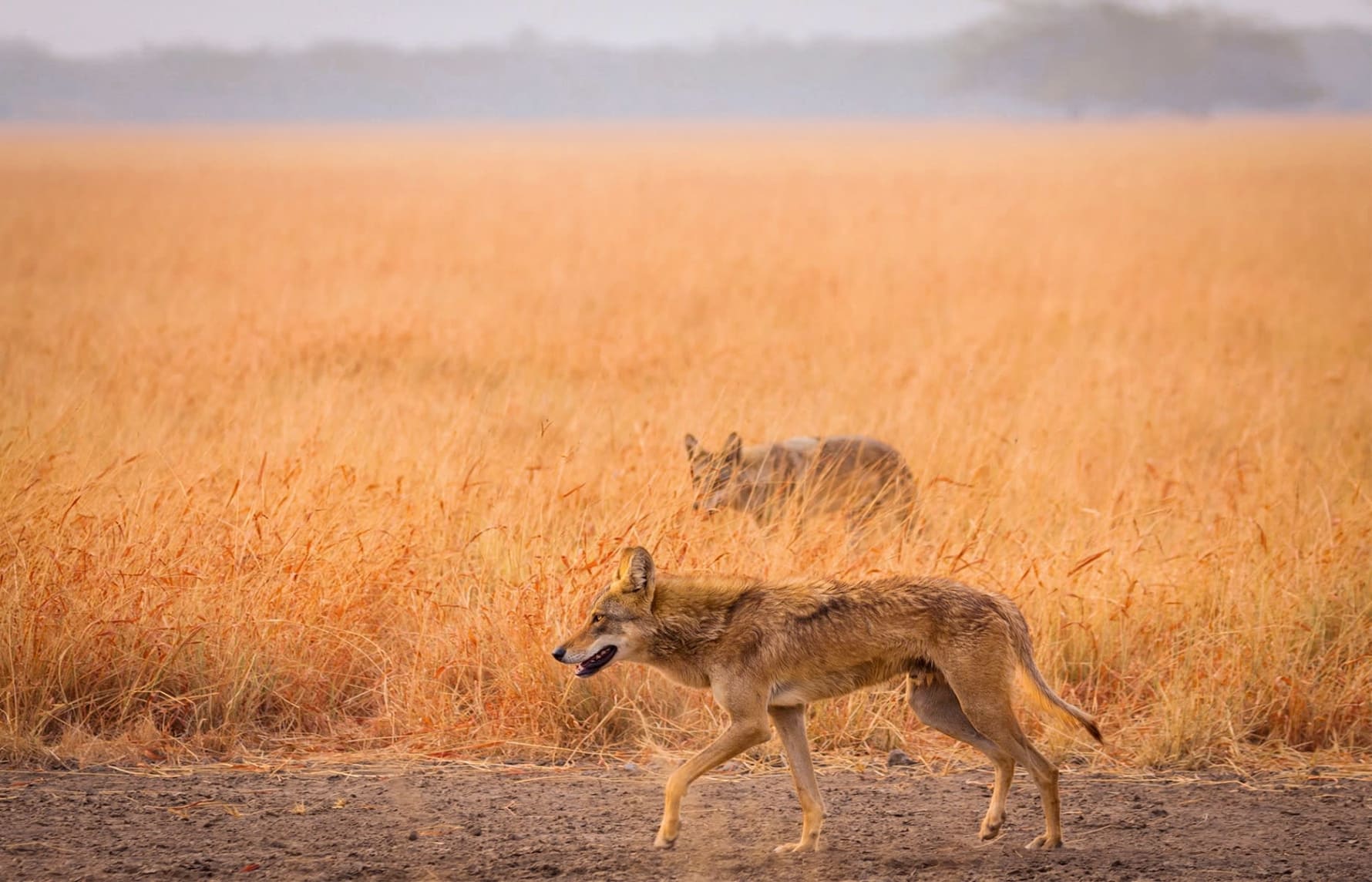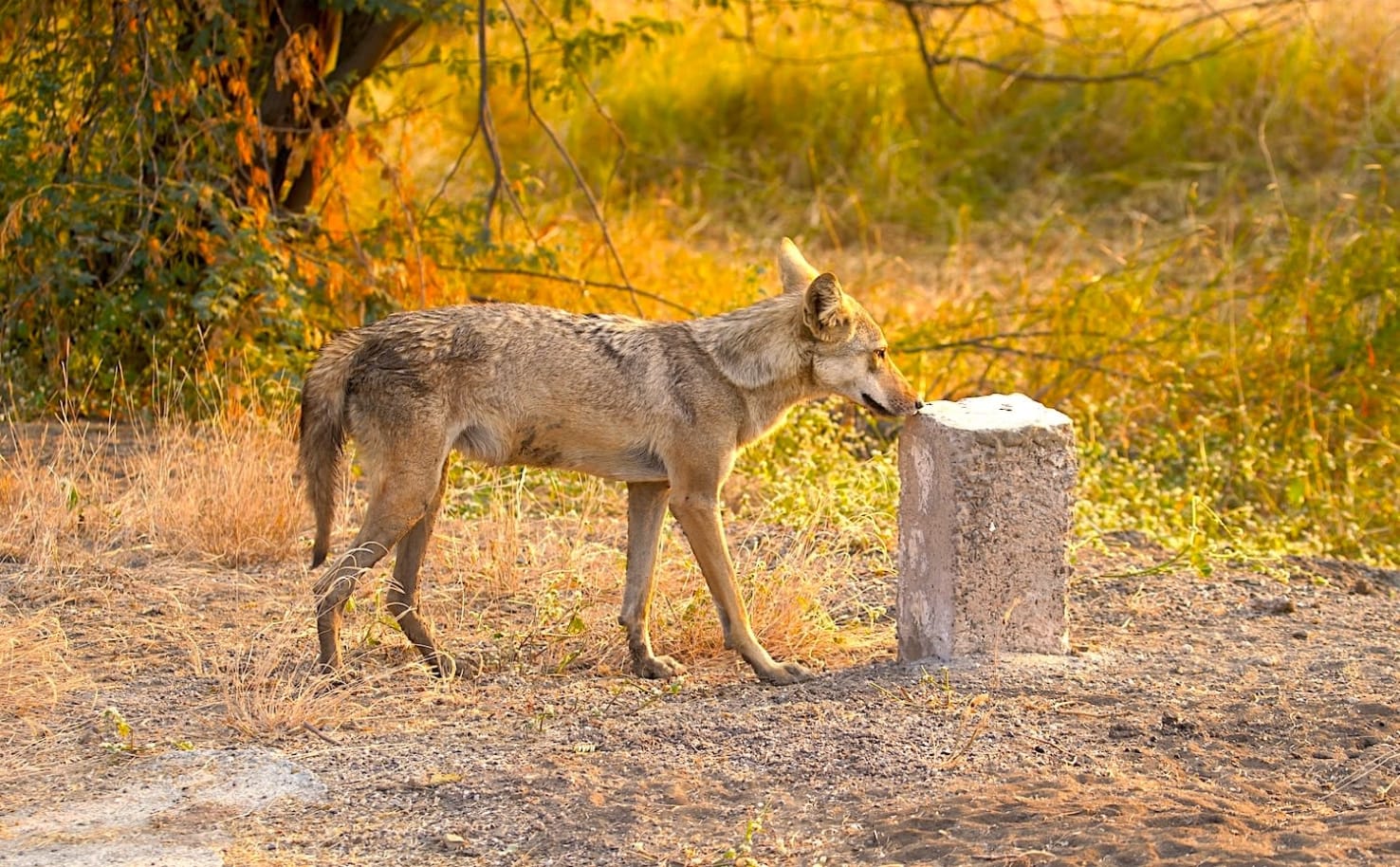 Listen to this article
•
15:34 min
Listen to this article
•
15:34 min
Memories are funny creatures. We never know which ones will endure or perish, and which we’ll embellish. What we do know is that we can’t predict when and where they will emerge without warning. In early December 2019, a chance sighting of a lone wolf at the Blackbuck National Park in Velavadar, Gujarat, transported me back nearly four decades, to the cool, dark belly of Sterling Cinema, in what was then called Bombay. Disney’s The Jungle Book movie had been released and had taken over our lives. With multiple viewings in the theatre (I saw it four times), and innumerable recounting of it with peers in building compounds, we formed fan clubs with Baloo and Bagheera leading the pack. Even back then, the less popular wolf pack resonated with me most, especially Akela, the leader and embodiment of grace and gravitas.

Wolves are the apex predators of Velavadar’s Blackbuck National Park, where they feed on blackbucks and other smaller ungulates. Photo: Dhritiman Mukherjee
Cover photo: The Indian wolf lives in semi-arid and arid areas. Its range extends from the Indian subcontinent all the way to Israel. Cover Photo: Dhritiman Mukherjee
When a lone male wolf ambled nonchalantly out of the bushes, not ten feet from our jeep as I took the last of my safaris in Velavadar, I was taken by surprise by a flash of memories. Instead of scampering off skittishly as I’d expected, the wolf paused, considered us with a regal, almost insouciant air, and then circled around us sniffing. I was initially puzzled by the otherwise reticent predator’s boldness, when Amit Vegad, the naturalist accompanying me from Blackbuck Safari Lodge, informed me that this was their breeding season. Almost on cue, the male wolf, who Amit called “naar” (local name) scent-marked a milestone right behind our car, before going on to mark a tree and a thicket just off the road. He then used his hind legs to scratch-mark the entrance to a much-trodden track leading off into the grasslands, where I hoped to observe and understand its species better over the next few days of safaris. But neither Amit nor Vishal Zapadiya, the jeep driver for most of our safaris, could have predicted the sheer number of rare and unusual behaviours we’d all get to observe.
The Indian wolf (Canis lupus pallipes, since we love formal introductions that indicate background) is a smaller version of the more familiar grey or timber wolf. Though its coat isn’t as lush its cousin’s, it is still quite the showstopper. It ranges, in patches, across most of India except the states of the Northeast. Velavadar is one of the few places it can be sighted fairly easily, not only because it is protected there, but also because the nature of the grassland allows for better visibility than thick jungle. In addition, the plentiful prey in this park ensures the flourishing of a stable, resident wolf pack. A pack typically has five or six members. We saw a pack of five wolves on three occasions as we tracked them across the rolling vidis (grasslands) of the area.

Amit told me that the wolf is respected, even feared locally, but interestingly, it is also considered a friend of the farmer in these parts, because it keeps the blackbuck and nilgai populations under check and away from the fields. The farmers keep watch every night during the crop growth season and if a wolf, solo or with its pack, settles into their fields for the night, the farmers also settle down knowing that herbivores won’t come in to graze in their fields until the wolves leave in the morning. This combination of respect and fear was something I got to see first-hand.
Locals believe that pregnant or menstruating women are particularly vulnerable to wolves because their hormonal state. This belief allegedly took root 20 years ago when a pregnant woman surprised a wolf in the fields and lost her life in the resulting skirmish. It remains the only documented case of human-wolf conflict in the area. Since then, the women of the area give the wolves wide berth. I saw this on another safari when a local woman, one of many employed by park authorities to cut dry grass was walking straight towards where a wolf was sitting in the middle of the grassland. Amit called out a warning to her. She looked up, saw the wolf’s head peering above the grass, stiffened, and quickly but calmly turned back towards us and continued working in another part of the grassland.

On another safari, we were lucky to get a glimpse of how love and hormones play out among Indian wolves. We were setting off on our second circuit of the main grassland one afternoon when a lithe female wolf emerged from the grass barely 15 metres from the road. Before I could focus my camera on her, the grass parted and a male wolf trotted out behind her. Realising that this was breeding season and we may get to witness wolf courting behaviour, Vishal killed the engine as the lupine couple came to life beside our car. This breeding pair put on a 15-minute-long Raas-Leela-type performance: there was tentative sniffing, gambolling, cutting each other off, trotting, leading each other on a merry chase, wrestling, and gentle nipping. Amit and I were grinning, thankful to have this opportunity to witness these overtures, when a low whistle from Vishal caused us to turn around. An awestruck Vishal pointed to a sub-adult wolf skulking out from a thicket and following what we assumed were its parents. As parents will attest, children can be romantic dampers, and the arrival of the sub-adult put an end to the frolicking. The three wolves retired into the bushes under the shade of an acacia tree nearby when suddenly the male reared up like he’d seen a snake. We heard frantic squealing, and an adult wild boar shot out from one side of the bush. Before we knew it, the male wolf was trotting away from us and towards the centre of the grassland with a piglet in its mouth. Out of view of my zoom lens, the family settled down to enjoy their evening snack, as the three of us were left to chew over this most unusual sequence of events.
But the wolves weren’t done yet. The park is bisected by the main village road and the wolves often cross it to go to the wetland on the other side. After their meal, the wolf family crossed over to the other side to slake their thirst. We thought we’d seen the last of them and got off at the entry gate to stretch our legs. Instead, we were presented with the incredible sight of the breeding pair running back, loping away from us, and then using the police barriers as an effective way to end my photographic pursuit of them. This entire sequence of events left me gaping and both Amit and Vishal were shaking their heads and whooping like excited children who’d finally seen Santa Claus. Going by how happy they were, it did seem like Christmas had come a few weeks early to Velavadar. And it did for me, considering that over four safaris, I was lucky enough to have sighted 25 wolves!

But it was on my first safari into the park on day one, when we were also the first jeep to drive in, that I encountered the first of many flashbacks of my childhood, uncoiling like Kaa in the boughs. Amit, Vishal, and I had barely driven a kilometre when we stopped parallel to a hyena den to see if the resident pair was shuffling about or setting off on their patrols. Suddenly, Amit hushed us into silence. In the few seconds before I could hear why, I saw Amit and Vishal’s eyes grow wide in wonder. This was the first time that the two of them were hearing a wolf pack howling in the daytime. My companions had a combined 14 years of tracking and guiding experience in the park, making this a truly historic record of the apex predator’s natural behaviour. The Indian wolf is not as vocal as its better known North American cousins and so, hearing packs howl at night is rare, let alone under a brightly shining sun. The clock stopped ticking and I was back, reading The Jungle Book, imagining the Seeonee Wolf Pack voice their call from atop Council Rock. We followed the direction of the sound, not expecting to see much more than a tail disappearing through the grass. But lo, when we cleared a copse of acacia trees, we came across five wolves, sitting unperturbed not 10 m from the road! A few seconds into our frenetic picture-taking, they got up, one by one, and strolled off into the thicket. Only the pack leader was left, sitting with paws crossed, surveying our intrusion with the elegant disdain it deserved. And I knew then that nearly forty years after I first started looking, I’d finally found Akela.






